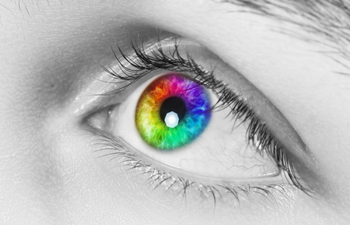Two Different-Colored Eyes: All about Heterochromia and DNA

Two Different-Colored Eyes: All about Heterochromia and DNA
Have you ever met someone whose eyes are two different colors? You may unwittingly stare at them for a minute trying to figure out what’s “different,” before it finally dawns on you that each of their eyes is a unique color! It’s actually a very beautiful phenomenon that can be observed not only in humans, but also in cats and dogs and other animals. Only 1 percent of people have heterochromia. So is it DNA or is it the result of something else? Here’s how it happens.

Where Does Your Eye Color Come From?
Everyone’s eyes contain a pigment called melanin, which helps determine hue. Have you ever noticed that all newborn babies’ eyes look blue? That’s because developing eye color is a relatively slow process that takes about eight weeks to complete. During this time, two specific genes are working together to code for color, and the genetically-designated amount of melanin “colors in” the irises to its predetermined color: brown, hazel, green, etc. The upshot is:
Lots of melanin: brown eyes Little melanin: blue or grey eyes Middling amounts of melanin: hazel or green eyes
DID YOU KNOW?Scientists believe blue eyes came about as the result of a genetic mutation 6,000 to 10,000 years ago and that everyone used to have brown eyes.
So How Do People Get Different-Colored Eyes?
These are the categories for heterochromia, although a single person could actually exhibit a combination of two or even three:
Complete (each eye is a different color) Central (the iris is one color, while a different color surrounds the pupil) Sectoral (a piece of one or both irises is a different color from the rest of the iris)In most cases, people are born with different-colored eyes due to family genetics, but sometimes, it can actually come about for different, non-DNA-related reasons. If you or someone you know has heterochromia, it’s probably due to one of the following reasons.
Genetics: Heterochromia is a dominant trait, so if a person is born with it, chances are good that this characteristic look comes courtesy of the family gene pool. Genetic Mutation: A mutation can happen during embryonic development that affects one or the genes involved in determining eye color. Trauma during Birth: If any type of trauma occurs in the facial area during birth, there’s a chance it could prevent melanin from coloring in the iris the way it was genetically programmed to. Accident: If a person suffers an injury in the facial area during their lifetime or has eye surgery, it could change their eye color on that side of the face. Some types of medication can also cause heterochromia. Disease: Some conditions such as Sturge-Weber syndrome, Bourneville disease, and more, can definitely result in the onset of heterochromia at any time.

The Bottom Line about Different-Colored Eyes
If you or a family member were born with heterochromia, know that it’s an absolutely natural occurrence that most likely came from your ancestors, and you are quite unique in the population. And who doesn’t want to stand out from the crowd, right?


Comments (0)